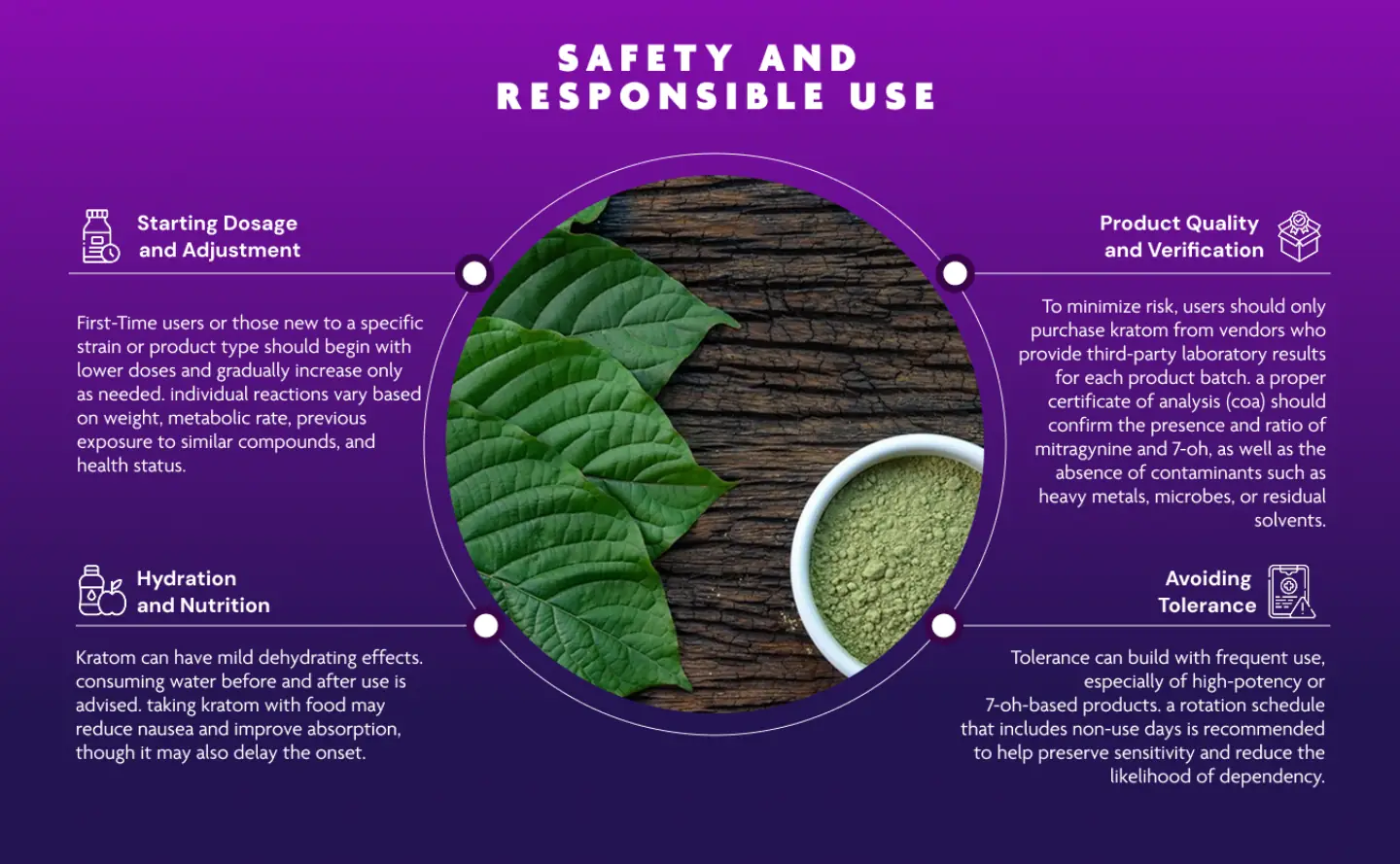Kratom and 7-Hydroxymitragynine (7-OH) Guide
Kratom (Mitragyna speciosa) is a tropical plant native to Southeast Asia that has gained international recognition for its natural ability to support energy, relaxation, and overall well-being. Traditionally used in countries like Thailand, Malaysia, and Indonesia, kratom is valued for its capacity to produce stimulant, analgesic, and sedative outcomes depending on dosage and strain.
In recent years, scientific and commercial interest in kratom has grown, particularly with the emergence of more concentrated formulations and purified alkaloids such as 7-hydroxymitragynine. This guide outlines the core properties of kratom, its strain classifications, key alkaloids, and considerations for safe and informed use.
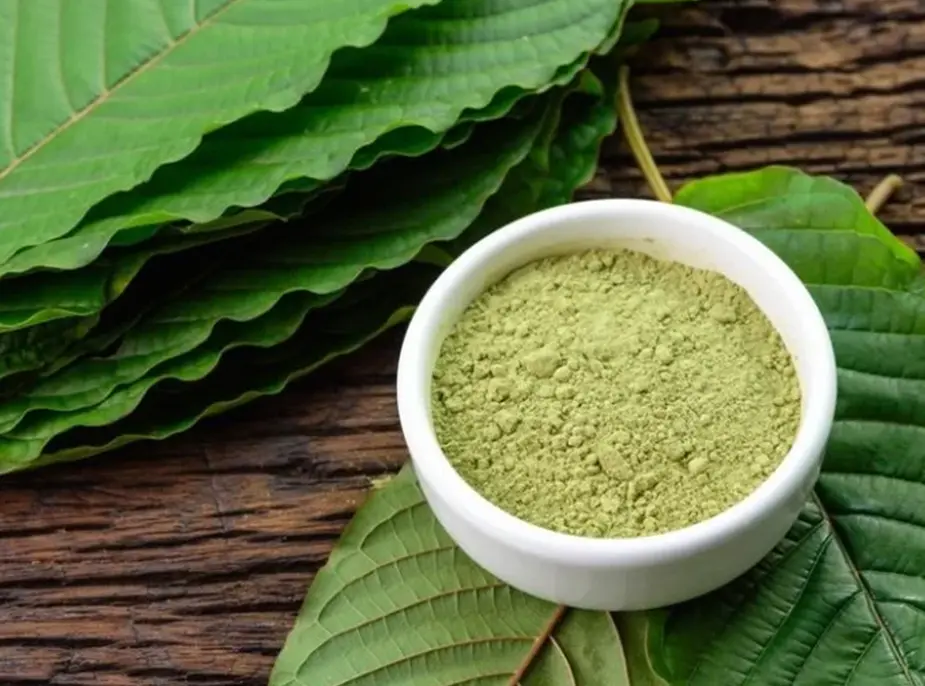
History of Kratom
Kratom has deep roots in Southeast Asian traditional practices, particularly in Thailand, Indonesia, and Malaysia. For centuries, it was used by rural laborers and villagers as a natural remedy and daily stimulant. Workers chewed fresh leaves to combat fatigue and improve endurance during long hours in the field. In folk medicine, kratom was brewed into teas to relieve common ailments such as pain, cough, and infections.
By the mid-20th century, kratom use became widespread enough in Thailand to prompt legal restrictions, partly due to its role as a natural substitute for opium. Despite this, kratom remained culturally significant in many rural communities. In recent decades, shifting attitudes and global interest in plant-based wellness have led to renewed scientific and regulatory attention, with Thailand legalizing its use again in 2021 for medical and research purposes.
Use Cases
Traditional Context
- Sustained energy and stamina for physical labor
- Herbal remedy for digestive issues and pain
- As a tool for managing opium withdrawal
- Cultural or ceremonial use
Modern Context
Today, kratom is used far beyond its regional origins. While individual motivations vary, common modern applications include:
- Natural alternative for managing chronic discomfort
- Mood support and emotional regulation
- Focus and energy enhancement for daily tasks
- Aid for rest and relaxation, particularly in the evening
- Informal support in managing withdrawal symptoms (though not medically approved)
Many users now treat kratom as part of a functional wellness routine, comparable to how others use caffeine, CBD, or adaptogenic herbs.
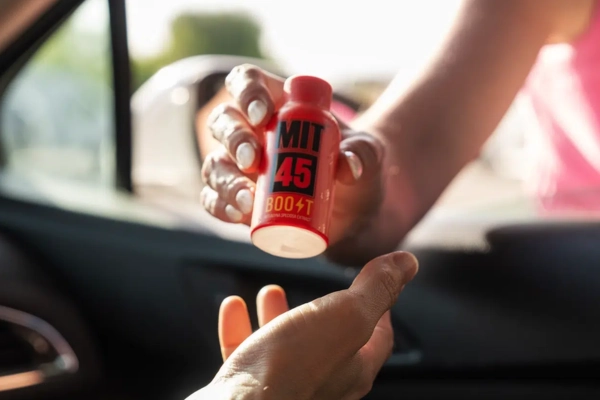
Mechanism of Action
Interaction with Opioid Receptors
Kratom’s primary mode of action is through opioid receptor binding, particularly the mu-opioid receptor (MOR). Mitragynine binds as a partial agonist, producing dose-dependent stimulation and analgesia. 7-OH, by contrast, acts as a full agonist at MOR with significantly stronger receptor affinity, leading to more pronounced and rapid sedation and analgesia.
Activity Beyond the Opioid System
In addition to opioid pathways, kratom alkaloids interact with noradrenergic, dopaminergic, and serotonergic systems. These secondary actions help explain kratom’s energizing, mood-lifting, and anxiolytic properties. Research has also identified kratom’s potential to influence calcium and sodium channel activity, further diversifying its neurological effects.
Duality of Effects
Kratom’s dose-dependent bifurcation means that low to moderate doses typically yield stimulating and euphoric effects, while higher doses tend to produce calming, sedating, and analgesic responses. This is a critical consideration in determining strain suitability, optimal dosage, and timing of use.
Alkaloid Profile of Kratom
Kratom’s effects are driven by naturally occurring compounds in the plant called alkaloids. While kratom contains over 40 alkaloids, just a few are responsible for the majority of its effects. Understanding how these key components work can help you choose the right strain, format, and dosage for your needs, because each good has it’s own set of dosage recommendations, like it happens with Kava dosage.
Here’s what you need to know about the most important alkaloids in kratom, and how they shape your experience:
Mitragynine
Mitragynine is the primary alkaloid in kratom, making up around 50–66% of the total alkaloid content in most leaves. It’s especially active at mu-opioid receptors, the same ones involved in managing discomfort, mood, and feelings of reward.
But mitragynine also interacts with other systems in your body, including adrenergic and serotonergic receptors, contributing to:
- Increased alertness
- A mild boost in mood
- Light, functional discomfort relief
Its most notable feature is dose-dependent duality:
- Low doses tend to feel more stimulating and energizing
- Higher doses are more calming and sedative
7-Hydroxymitragynine
Although it makes up less than 0.05% of the alkaloid content in raw kratom, 7-hydroxymitragynine packs a powerful punch. It binds strongly to mu-opioid receptors, with a potency estimated to be several times greater than morphine by weight.
Why does this matter to you? This alkaloid is a major contributor to the sedative, calming, and analgesic effects found in red strains and extract-based products. It’s also fast-acting, often producing noticeable relief within 15–30 minutes when present in concentrated formats.
Mitragynine Pseudoindoxyl
This compound isn’t something you’ll find in many kratom products. It’s a metabolite, meaning your body converts mitragynine into this form after ingestion. It may offer strong pain-relief potential with a lower risk of side effects like respiratory depression, which is a common concern with traditional opioids.
It interacts with multiple opioid receptors (mu, delta, and possibly nociceptin), suggesting a more complex and possibly safer mechanism of action. Though not yet available as a standalone ingredient, ongoing research into mitragynine pseudoindoxyl could help shape future kratom-based therapies with improved safety profiles.
Kratom Strains
Red Vein
Red kratom is distinguished by its higher concentration of sedative alkaloids, especially 7-OH. These strains are harvested later in the leaf lifecycle and often undergo specific drying methods that enhance 7-OH development.
Red strains are used primarily for evening relaxation, sleep support, and discomfort management. Their effects tend to be calming, making them useful for people seeking relief from restlessness, chronic tension, or overstimulation.
Green Vein
Green strains represent a balanced alkaloid profile that provides moderate stimulation and mental clarity without the jittery edge of white strains or the sedation of reds.
Green kratom is suitable for midday productivity, light mood elevation, and focused energy. It is commonly used by individuals seeking a non-synthetic cognitive boost or as a functional aid in work or study settings.
White Vein
White kratom is typically harvested earlier and contains higher levels of mitragynine and fewer sedating alkaloids. It is regarded as the most energizing strain class, often used as a natural stimulant.
Effects may include increased physical energy, enhanced motivation, and sustained focus. White strains are commonly used in the morning or before tasks requiring mental engagement or physical endurance.
Yellow Vein
Yellow strains are not a naturally occurring phenotype but are created through post-harvest modifications, including fermentation or extended drying. These processes alter the alkaloid content and may produce a mellow, steady set of effects.
Yellow kratom is characterized by its longer duration of action, gentle stimulation, and subtle relaxation. They are suitable for new users or those seeking consistent relief without intensity.
Gold Vein
Gold kratom is generally a hybrid strain or fermented product, combining properties of both red and white veins. It produces balanced effects that offer mental uplift alongside mild sedation.
Depending on the ratio and method of preparation, gold strains can be used in both daytime and evening settings. Their versatility makes them a popular option for users who prefer all-purpose use cases.
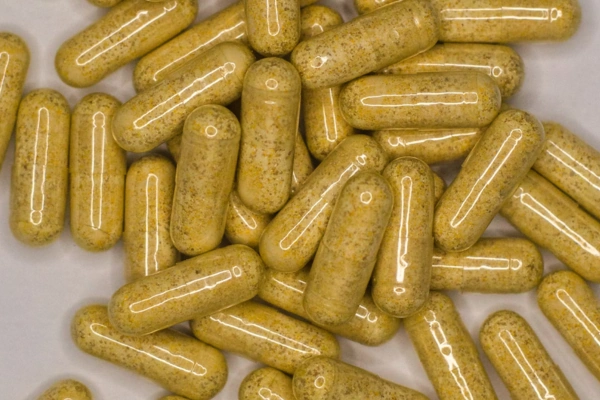
Delivery Formats
Capsules
Kratom capsules are among the most convenient methods of ingestion. They contain a standardized amount of powdered leaf, enclosed in gelatin or vegetarian capsules. Capsules provide precise dosing, eliminate the bitter taste of kratom powder, and are preferred for discreet, on-the-go use. The onset of effects is slightly delayed due to digestion time, but typically begins within 30 to 60 minutes.
Capsules are especially popular among people new to kratom. They’re also ideal for anyone sensitive to taste or texture. However, because the effects take longer to kick in, capsules may not be the best option if you’re seeking fast relief or need precise control over onset.
For some, pairing capsules with a light meal can help reduce digestive discomfort, especially when starting. They’re often favored in work or travel settings where discretion and simplicity matter.
Powder
Kratom powder is the most traditional and cost-effective format. It consists of dried, milled leaves and is often consumed via brewed tea, mixed beverages, or direct ingestion (toss and wash). Powder offers greater control over dosage, faster absorption, and flexible administration. However, it has a strong, bitter taste that some users find unpleasant.
Powder remains the go-to for experienced users who want the most control and flexibility. It’s also the preferred choice for anyone interested in crafting blends, teas, or even capsules. Some users create kratom “recipes” to mask the taste, mixing powder with citrus juice, smoothies, or yogurt.
While it requires a bit more effort and tolerance for its flavor, the faster onset and cost savings make powder a long-term favorite for regular use. Those who value ritual often find powder the most satisfying way to use kratom.
Liquid Extracts and Shots
Kratom shots and liquid extracts are highly concentrated preparations that use solvent-based extraction methods to isolate active alkaloids. These products are fast-acting, typically producing effects within 15 to 30 minutes. They are ideal for users seeking rapid relief or stronger outcomes from lower volumes. Quality varies greatly among manufacturers, and third-party lab testing is essential.
Due to their concentration, liquid extracts are best suited for occasional use or as part of a rotation strategy. They’re commonly chosen by users who want immediate impact.
However, because extracts bypass the slow digestion process and deliver more alkaloids at once, it’s easier to build tolerance if used frequently. If you’re using extracts, start with half servings and assess potency, especially if you’re new to enhanced products.
Soft Chews
Soft chews are a modern edible format offering measured doses of kratom in a palatable and portable form. These chews are often flavored and offer a convenient alternative to capsules or powders. Onset and duration are similar to capsules, though variability may occur based on the chew’s base ingredients.
Soft chews bridge the gap between edibles and extracts. They’re often selected by users who want a tasty, pre-dosed alternative that doesn’t feel clinical or supplement-like. Because they’re more approachable and familiar, they’re especially useful for people easing into kratom for the first time.
Chews may contain sweeteners, gelatin, or filler ingredients that some prefer to avoid. They also tend to cost more per dose due to the convenience factor. If you like kratom but dislike the formality of capsules or the intensity of powder, soft chews are a great in-between option. Talking about great options, you should check out the Mitragynine Pseudoindoxyl soft chews too.
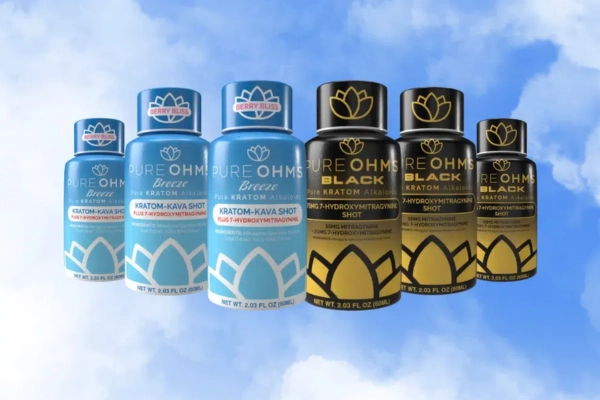
7-Hydroxymitragynine: Properties and Use
7-OH stands out for its potency and pharmacological importance, despite being present only in trace amounts. While mitragynine is the most abundant alkaloid in kratom and is largely responsible for its broader range of effects, 7-OH is significantly more powerful by weight and plays a major role in kratom’s stronger sedative and analgesic outcomes.
Natural Occurrence and Manufacturing
Despite this low concentration in the kratom leaf, it is remarkably potent due to its high affinity for mu-opioid receptors, which are involved in regulating pain, sedation, and emotional state.
Because of this potency, some kratom products are intentionally enhanced by extracting and concentrating 7-OH. This is typically done using specialized methods such as ethanol extraction, CO₂ processing, or supercritical fluid techniques that isolate and purify the alkaloid. These enhanced extracts are then used in premium tinctures, softgels, or fast-acting capsules.
It’s worth noting that even small amounts of added 7-OH can significantly amplify a product’s effects, making it appealing to experienced users or those seeking rapid relief. This also means dosing becomes more sensitive and requires greater care.
Pharmacological Effects
Compared to mitragynine, which is a partial agonist, 7-OH acts as a full agonist at the same opioid receptor sites. This means it binds more strongly and produces more intense effects. Most notably:
- Deep analgesia for discomfort management
- Sedative effects useful for rest and sleep support
- Anxiolytic properties that can reduce stress and emotional tension
These effects typically appear within 15 to 30 minutes, making 7-OH a common ingredient in products marketed for fast-acting relief, particularly in evening or nighttime use.
Due to its strength, users often describe the effects as less functional and more immersive compared to regular kratom powder. It’s not well-suited for daytime productivity or light mood support, but can be highly effective for short-term discomfort or when winding down.
Dosing and Tolerance
The high potency of 7-OH comes with a higher risk of tolerance and dependency if used too frequently. Regular use can lead to reduced sensitivity not only to 7-OH but to other kratom alkaloids as well. This is why most experienced users treat enhanced products as occasional tools, not daily staples.
Safe use involves starting with very low doses, especially when using a new product or blend. It’s critical to look for clear labeling and to only buy from vendors who provide third-party lab tests that disclose the exact 7-OH content. This ensures you’re not consuming more than expected and helps reduce the risk of unpleasant side effects.
Users are also advised to avoid mixing 7-OH-based products with other central nervous system depressants such as alcohol, benzodiazepines, or opioids, as this could increase the risk of sedation-related complications.
